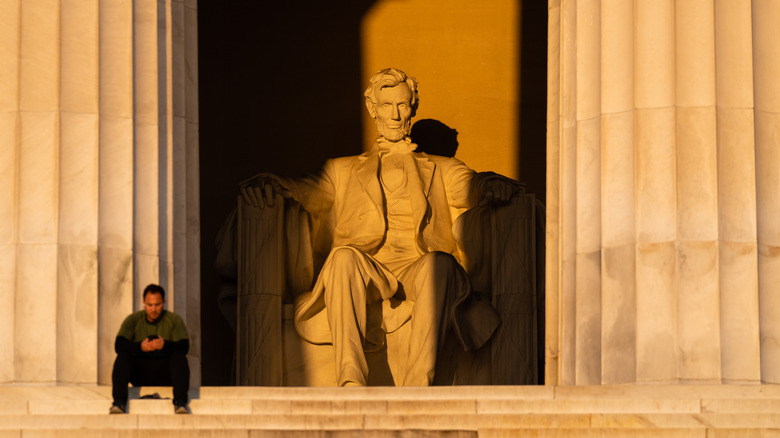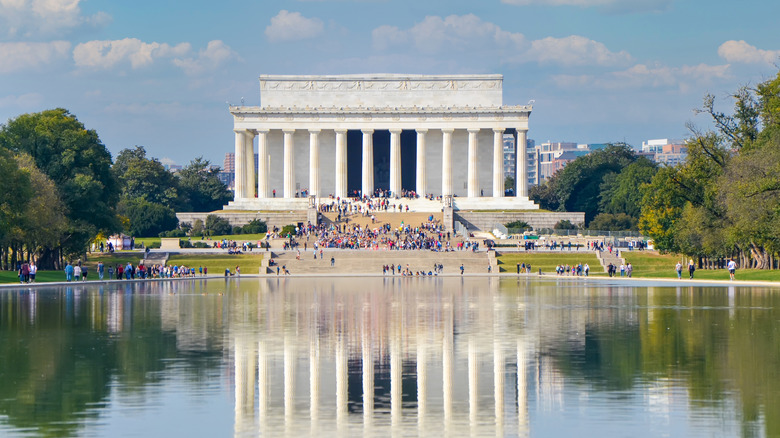Why Do The Lincoln Memorial's Walls Tilt Inward?
We may receive a commission on purchases made from links.
The Civil War might go down as one of the most trying moments in American history. From 1861 to 1865, scores of Union and Confederate soldiers fought each other in the ultimate battle of morality: ending slavery. Life wasn't particularly easy for a soldier during that time, and historians estimate that the war might have taken the lives of up to 851,000 soldiers, according to Britannica.
That might be one reason why Abraham Lincoln is so revered today. The 16th U.S. president was born on February 12, 1809. Lincoln is considered by many people to be one of the most important figures in American history. His most notable achievements include leading the Union through the Civil War and helping to end slavery, as related by History. Today, he is remembered as a president who helped bring the country together in a divided time. His name and likeness are found throughout modern life, from the $5 bill to the names of cities, counties, streets, and schools.
The Lincoln Memorial in Washington D.C is one such example of remembrance. The story of its construction has its unique aspects — including the tilt of the walls.
The Lincoln Memorial's walls tilt inward to compensate for perspective
The Lincoln Memorial is, without a doubt, one of the most popular destinations in the United States. Attracting millions of people per year, it's clear that this historical site is one of intense fervor, according to DCist. And with that fervor, comes questions about its history and its place among American iconography.
The Lincoln Memorial was designed by Henry Bacon. History relates that the memorial was first approved by Congress in 1867, but disputes over design, location, and funding derailed it. Congress stepped up once again and provided the money in 1911, but construction was slowed with the advent of World War I. Finally, the memorial was completed in 1922, according to Britannica. Its design was inspired by the Parthenon in Athens, another massive structure with marble columns, and made to commemorate Lincoln's legacy as the great emancipator. The Greek influence wasn't the only possibility; another designer, John Russell Pope, pitched a memorial based on an Egyptian pyramid, as well as one resembling a Mayan temple, complete with steps. (Pope went on to submit the winning design for the Jefferson Memorial.)
On the outside, the memorial looks fairly symmetrical, but this is actually quite deceiving. The whole of its exterior actually leans inward, according to the National Park Service. In their words, this is "to compensate for perspective distortions which would otherwise make the memorial appear asymmetrical."
The Lincoln Memorial's design is an optical illusion
The Lincoln Memorial itself is comprised of five sections: the plaza, columns, steps, frieze, and cornice. According to the National Park Service, there are 36 columns, all of which are made of marble. Each column represents a state that was in the Union in 1865. These exterior elements use architectural compensation for a phenomenon known as perspective distortion. Basically, it's an optical illusion.
In general, the human eye tends to see things as much larger than they actually are the closer one is. So, depending on where one's position is in relation to a building, it may appear entirely different to them (via Master Class). Some architects account for this and work it into construction itself, as in the case of the Lincoln Memorial.
While the memorial may seem completely uniform and flat, there's actually quite a bit of depth (no pun intended) to the structure. One should keep that in mind the next time they make a visit.


